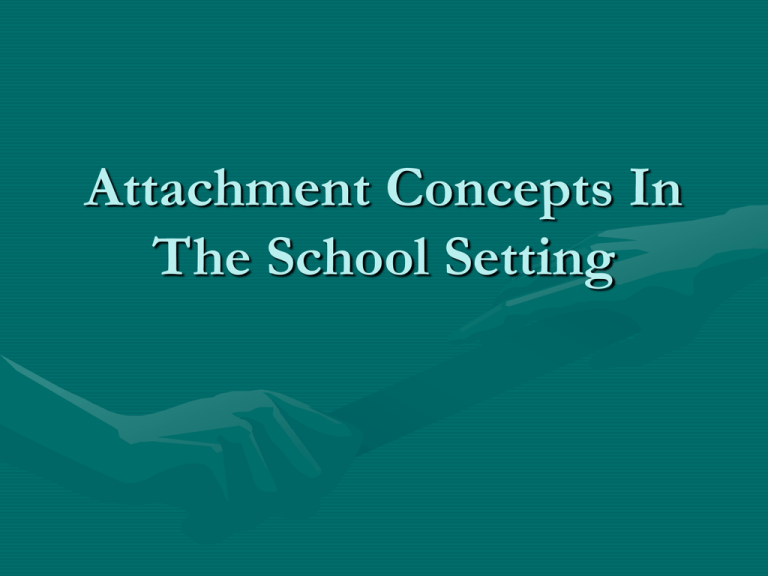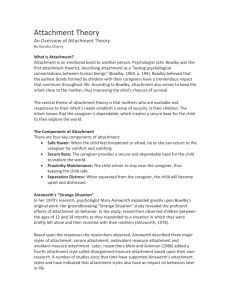Attachment Concepts In The School Setting
advertisement

Attachment Concepts In The School Setting What do we call them? The “troubled “ children • • • • • • • Conduct Disordered Oppositional Defiant Aspergers Naughty Crazy Psycho Having bad parents Attachment Theory • Attachment is the deep and enduring connection established between a child and caregiver in the first years of life • Profoundly influences every component of the human condition • Ongoing reciprocal relationship between child & caregiver • Infants instinctively seek a “secure base” to protect & nurture them Attachment theory • Attachment process is a “mutual regulatory system”- infant & caregiver influencing one another over time • Helps develop our Internal Working Models • Begins before birth @ neurological & emotional level • Infants needs are met > Trust Cycle, Circle of Security Secure Attachment • Around 80% of pop. • Learn adults can be relied upon, develop trust & reciprocity • Create foundation for identity • Develop resourcefulness & resilience • Learn how to communicate • Handle frustration & distress better • Have better self esteem & empathy • Better understanding of negative emotions Secure Attachment • Self-esteem • Independence & autonomy • Resilience • Manage impulses & feelings • Long-term friendships • Prosocial skills • Trust, intimacy & affection • Empathy, compassion & conscience • Behaviourial performance & academic success • Promote secure attachment in their chn Attachment Disorder • Failure to develop a secure attachment • Chn who begin life with disrupted and compromised attachment are at risk of developing serious problems • Vary in severity, but show lack of ability to be genuinely affectionate with other • Typically fail to develop a conscience & learn not to trust Traits & Symptoms • Behaviour: defiant, oppositional, impulsive, lie (crazy), steal, cruel to animals, fire setting, aggressive, self-destructive • Emotions: intense ange & temper, sad, depressed, moody, fearful & anxious inappropriate emotional reactions • Thoughts: negative internal working models, lack of cause & effect thinking, attention & learning problems • Relationships: lack of trust, controlling, manipulative, blame other for mistakes, vitimises, indiscriminately affectionate with strangers, trouble giving & receiving love & affection • Physical: poor hygiene, accident prone, high pain tolerance, enuresis& encopresis, tactilely defensive • Moral: lack of remorse, compassion & other prosocial values; identification with evil & dark side of life Causes of Attachment Disorders 1. Caregivers: * abuse / neglect • Ineffective care • Depression bipolor • Substance abuse • Prolonged absences • Intergenerational • Teenage parenting • Psychological disturbance 2. Child: • Difficult temperament • Premature birth • Medical conditions • Hospitalistions • Failure to thrive • Congenital/biological problems • Genetic factors family histories Causes of Attachment Disorders 3. Environmental • Poverty • Violence : victim or witness • Lack of support to caregiver • Multiple out of home placements • High stress: marital conflicts, family choas, violent community • Lack of stimulation So at school what do we do? • Be aware of the behaviours & symptoms and discuss with school counsellor, LST • Students with attachment disorders are very controlling, manipulative & self-centred • They will attempt to control everyone around them Tips for Teachers • Establish eye contact. When angry they will have excellent eye contact • Establish who is the boss: “That’s right I am the boss, but fair & good” • Win control battles: Always give them a choice • Recognise attempts to control:They will do “little things” to put themselves in control of every situation • Allow the child to accept responsibility: to experience natural consequences • Be consistent: confront each misbehaviour-support good behaviour Tips for Teachers • Remain clam: they are in control when the teacher “looses it” • Model and verbalise desired behaviour • Document interactions & observations: helps in planning & communication to parents; protects the teacher • Request help: supportive staff esp. management Attachment Theory • Provides a model to help understand behaviour • It is a behaviour style of relating to your child, not about love. • Traditional therapies aren’t very affective • Three clients involved: parent-the relationshipchild The School • Can be a secure base • Can promote an understanding & reduce the blame of self & others • Can help reduce negative patterns & conflicts, model language & behaviour • Can increase positive interactions • Can help reframe the parents’ concept of the child to one of the child being distressed/reacting and needing to learn control Fear leads to Anger Anger leads to Hate Hate Leads to Suffering











